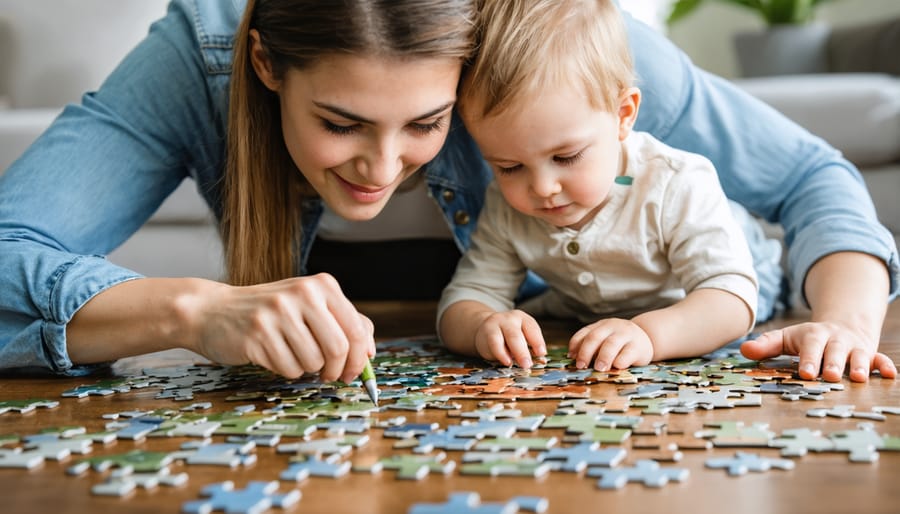
Transform your parenting journey today by implementing proven, mindful parenting habits that create lasting positive change. Modern parenting demands more than just intuition – it requires a thoughtful, structured approach that adapts to your family’s unique needs.
Raising confident, resilient children while maintaining your sanity isn’t about perfection; it’s about developing consistent, effective strategies that work for both parent and child. Whether you’re struggling with bedtime battles, homework resistance, or simply looking to strengthen your family bonds, these nine steps offer practical solutions backed by child development research and real-world experience.
By focusing on evidence-based techniques while honoring your natural parenting instincts, you’ll discover how small, intentional changes can dramatically improve your family dynamics. These strategies help create a nurturing environment where both parents and children can thrive, communicate effectively, and build stronger relationships.
Let’s explore the nine essential steps that will revolutionize your parenting approach and create lasting positive changes in your family life.
Create Consistent, Loving Boundaries
Setting Age-Appropriate Rules
As your child grows, so should your rules and expectations. I’ve learned through my own parenting journey that effective boundary setting needs to evolve with your little one’s developing abilities and understanding. For toddlers, keep rules simple and concrete: “gentle hands” or “inside voice.” As they reach school age, introduce more complex expectations around responsibility and time management, like homework routines or helping with age-appropriate chores. With teenagers, shift towards collaborative rule-setting, involving them in discussions about curfews and social media usage. Remember, flexibility is key – what worked for your 8-year-old might need adjustment when they’re 10. The goal isn’t to create rigid restrictions but to establish guidelines that help your child develop self-discipline and understanding of appropriate behavior.
Practice Active Listening

The Power of Eye-Level Communication
When communicating with your child, getting down to their eye level creates a powerful connection that speaks volumes. I remember the moment I started consciously kneeling to speak with my toddler – the difference in her response was immediate and remarkable. This simple act shows your child they have your complete attention and that their thoughts matter.
Make it a habit to physically lower yourself to their height during conversations, whether they’re sharing exciting news about their day or working through difficult emotions. This position eliminates intimidating power dynamics and creates a safe space for open dialogue. When you’re face-to-face, maintain gentle eye contact and listen actively without interrupting.
Remember, children are more likely to share their feelings and concerns when they feel truly seen and heard. This practice builds trust and strengthens your emotional bond, making future communications more effective and meaningful.
Model Emotional Intelligence
Let’s be honest – our little ones are watching us constantly, learning how to navigate their emotional world through our examples. As a mom of two, I’ve learned that building emotional resilience starts with us showing them the way.
When you’re feeling frustrated, take a deep breath and say out loud, “I’m feeling angry right now, so I’m going to take a moment to calm down.” This simple act shows your children that it’s normal to have big feelings and healthy ways to manage them. Share your joy openly too – let them see you celebrate small wins and express gratitude.
Create a safe space for emotional expression in your home. When your child is upset, avoid dismissing their feelings with phrases like “don’t cry” or “it’s not a big deal.” Instead, validate their emotions: “I see you’re feeling sad about losing your toy. That’s okay to feel that way.” This helps them develop emotional awareness and self-acceptance.
Remember those challenging moments in the grocery store or during bedtime routines? Use them as teaching opportunities. Narrate your own emotional regulation: “I’m getting frustrated, but I can handle this calmly.” This shows your children that emotions are manageable and that it’s possible to respond rather than react.
Make it a daily practice to check in with feelings during family time. Share your own emotional experiences and encourage your children to do the same. The more comfortable you are expressing and managing emotions, the more natural it becomes for your little ones to develop these essential life skills.
Make Time for Quality Connection
In our fast-paced world, it’s easy to fall into the trap of being physically present but mentally elsewhere with our children. I remember catching myself checking emails while my daughter was telling me about her day, and that moment was a wake-up call. Quality connection isn’t about the quantity of time spent together; it’s about being fully present in the moments we share.
Try establishing daily rituals of undivided attention. This could be as simple as a 15-minute bedtime chat or having breakfast together without screens. When your child speaks, practice active listening by maintaining eye contact and asking engaging follow-up questions. These small gestures show them that their thoughts and feelings matter.
Create opportunities for spontaneous bonding by keeping a “connection toolkit” ready. This might include board games, art supplies, or even a list of silly questions to spark conversations. Some of my favorite moments with my kids have been during impromptu living room dance parties or while baking cookies together.
Remember that connection happens in ordinary moments too. Turn routine tasks like folding laundry or preparing dinner into opportunities for conversation and laughter. Share stories from your own childhood, talk about their dreams, or simply enjoy comfortable silence together. These authentic interactions build trust and create lasting memories that strengthen your parent-child relationship.
By prioritizing quality connection, you’re not just spending time with your children; you’re investing in their emotional well-being and your relationship’s future.

Choose Your Battles Wisely
As parents, we often feel compelled to address every single issue that comes up with our children. But here’s a liberating truth: not every battle needs to be fought. Learning to differentiate between meaningful teaching moments and minor infractions can make parenting more enjoyable and effective for everyone involved.
I remember watching my daughter wear mismatched socks to preschool and catching myself before making it an issue. Was it worth the potential morning meltdown? Absolutely not. That day taught me an important lesson about picking my battles.
Consider these questions when deciding whether to address an issue:
– Does it affect safety or health?
– Will it matter in a week, month, or year?
– Is this a character-building moment?
– Does it impact others negatively?
Focus your energy on significant issues like honesty, respect, and safety. These core values deserve your attention and consistency. Meanwhile, small things like wearing pajamas to breakfast or creating artistic masterpieces on their bedroom walls (with washable markers) might not be worth the conflict.
Create a mental hierarchy of importance. For example, hitting a sibling requires immediate attention, while leaving toys scattered might be better addressed through a regular clean-up routine rather than daily arguments.
Remember, letting go of minor issues isn’t being permissive – it’s being strategic. By choosing your battles wisely, you’ll have more energy for the moments that truly matter in shaping your child’s character and development.
Stay Calm in Challenging Moments
Let’s be honest – parenting can test even the most patient among us. I remember the day my toddler had an epic meltdown in the grocery store, and I felt my blood pressure rising. That’s when I learned that staying calm isn’t just good for us – it’s essential for our children’s emotional development.
When challenging moments arise, try this three-breath technique: inhale deeply for four counts, hold for four, then exhale for six. This simple practice can help you regain composure before responding to difficult situations. Remember, our children learn emotional regulation by watching us navigate stress.
Create a mental “pause button” for yourself. When you feel overwhelmed, imagine physically stepping back from the situation. This brief moment allows you to assess the scenario with fresh eyes and respond thoughtfully rather than react emotionally.
Keep a few calming phrases in your parental toolkit: “Let’s take a moment to breathe together” or “I need a minute to think about this.” These statements model emotional awareness while giving you precious seconds to collect yourself.
Remember that staying calm doesn’t mean being perfect. It’s okay to tell your children, “Mommy is feeling frustrated right now and needs a moment to calm down.” This honesty helps them understand that managing emotions is a skill we’re all continuously developing.
Practice self-compassion during these moments. You’re not failing when you feel challenged – you’re growing alongside your child in this beautiful, complex journey of parenthood.
Foster Independence
I remember watching my daughter’s face light up the first time she successfully tied her shoelaces – it was a small victory that meant so much to both of us. Fostering independence in our children is one of the most challenging yet rewarding aspects of parenting, requiring us to find that delicate balance between protecting them and letting them spread their wings.
Start by identifying age-appropriate tasks your child can handle independently. For toddlers, this might mean letting them choose their clothes or help with simple chores. As they grow, gradually increase their responsibilities – perhaps packing their school lunch or managing their homework schedule. Remember, the goal isn’t perfection; it’s about building confidence through experience.
Create a safe environment that encourages exploration. Childproof your home strategically, but avoid overprotecting. Let your child experience natural consequences within safe boundaries – if they forget their lunch, they might feel hungry at school. These small lessons build resilience and responsibility.
Support their decision-making skills by offering limited choices. Instead of asking, “What do you want for breakfast?” try “Would you like oatmeal or eggs?” This approach helps them feel in control while keeping choices manageable. When they make mistakes, resist the urge to immediately jump in and fix everything. Sometimes, watching them problem-solve independently is more valuable than achieving a perfect outcome.
Remember, fostering independence isn’t about stepping back completely – it’s about being their safety net while they learn to fly on their own.
Practice Self-Care
Remember the airplane safety rule: put your oxygen mask on first before helping others. The same principle applies to parenting. Taking care of yourself isn’t selfish – it’s essential for being the best parent you can be.
As a mom of two, I’ve learned that incorporating mindful self-care practices into my daily routine helps me stay patient and present with my children. This could be as simple as enjoying a quiet cup of coffee before everyone wakes up, taking a 10-minute walk during naptime, or practicing deep breathing exercises when feeling overwhelmed.
Make self-care non-negotiable by scheduling it like any other important appointment. Whether it’s exercise, therapy, hobby time, or catching up with friends, prioritizing your well-being directly impacts your parenting effectiveness. When you’re recharged and balanced, you’re better equipped to handle tantrums, make thoughtful decisions, and model healthy emotional regulation for your children.
Remember, self-care looks different for everyone. Find what truly rejuvenates you and make it a regular part of your parenting journey. Your children benefit from having a parent who’s emotionally and physically well-cared for.

Build a Support Network
Parenting doesn’t have to be a solo journey. In fact, building a strong support network can make all the difference in your parenting effectiveness and overall well-being. I remember when my daughter started preschool – connecting with other parents during pickup time not only provided valuable friendships but also created a wonderful resource for sharing experiences and advice.
Start by reaching out to family members who can offer both emotional support and practical help. Join local parenting groups or online communities where you can connect with others facing similar challenges. These connections often lead to playdates, which benefit both children and parents alike.
Don’t forget to involve your children in building their own support networks too. Encourage relationships with trusted adults like teachers, coaches, or family friends who can serve as additional role models. This creates a safety net of caring individuals who can contribute to your child’s development and well-being.
Consider joining parent-teacher associations or community organizations that focus on families. These groups not only provide support but also help you stay informed about local resources and opportunities for both you and your children. Remember, it takes a village to raise a child, and there’s no shame in building and leaning on your village when needed.
Parenting is a journey of continuous growth and learning, and implementing these nine steps can transform your relationship with your children and create a more harmonious household. Remember, you don’t need to perfect all these strategies at once – start with one or two that resonate most with you and gradually incorporate others as they become natural habits. The key is consistency and patience, both with your children and yourself.
As a parent myself, I’ve learned that some days will be easier than others, and that’s perfectly okay. What matters most is your commitment to being present, showing love, and maintaining boundaries while nurturing your child’s independence. By focusing on positive reinforcement, active listening, and leading by example, you’re not just raising well-behaved children – you’re helping shape confident, resilient individuals who will carry these valuable life lessons into adulthood.
Take the first step today. Your family’s journey to more effective parenting starts now.



